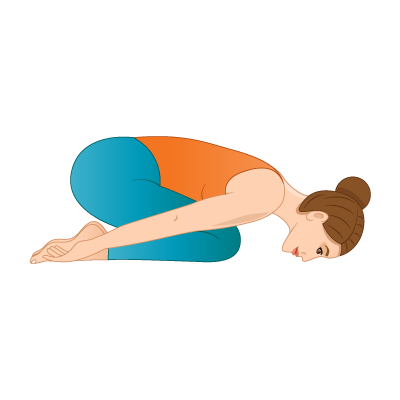Child Pose
Balasana

STEPS
Begin kneeling on the floor with the tops of the feet flat and the legs together. Release the upper body over the thighs, resting the forehead onto the floor. Place the arms alongside the body with the palms turned up. Allow the shoulders to roll forward releasing the mid back. To come out, place the hands underneath the shoulders and draw the belly back to lift the spine.
Child’s pose is a place of rest and can be used during transitions. If a student feels fatigued this is a good posture to pause in. It can be held anywhere from 30 seconds and up to 10+ minutes in a restorative yoga class.
TEACHER QUEUES
VISUALIZATION COMMENTS
Balasana is a place to surrender, to allow one’s self to feel small, safe, and protected, a cocoon to rest in. This is also a beautiful posture to reestablish the connection to the breath through the back space of the body. Encourage students to feel the back of their ribs expand with each inhale and to feel their spine lengthen with each exhale.
TECHNICAL COMMENTS
Roundback: Keep the knees together to allow the spine to round over the thighs. The arms can either be along side the body or stretched out in front of the torso. Drop the tail down and keep the back of the neck long to lengthen the entire spine. If the forehead does not reach the floor, the palms or fists can be stacked to rest the forehead, or support with a cushion.
Long Back: Spread the knees at least hip distance apart, allowing the spine to stretch long and straight towards the ground. Again, the arms can either be at the sides, or stretched out in front of the torso. Another nice option for Child’s pose is to clasp the hands together and slide the palms between the legs, turning the head to rest on one side of the cheek. To balance the neck in this variation, be sure to turn to look the other direction.
Restorative: As a Restorative pose this posture can be practiced for longer periods of time by supporting the body using props. Place a cylindrical bolster between the knees, either allowing the head to be supported on the bolster, or slide the bolster further towards the heels and let the forehead rest on the floor. For students with difficulty sitting on their heels or with knee injuries, place a cushion or bolster between the heels and buttocks, raising the hips up.
BENEFIT COMMENTS
- Stretches the ankles, thighs, hips, and back.
- Relieves tension and stress, by calming the nervous system.
- Relaxation.
- Massages the organs.
- Improves digestion.
WATCH OUT FOR
- Knee tracking, either knees knocking together or bowing out.
- Shoulders in the ears.
- Shortening the neck extensors by lifting the chin too high.
- Over arching the lower back.
- Tucking the bum.
- Ribs popping.
- Heels lifting.
CONTRAINDICATIONS
- Knee Injuries: See restorative technique above.
- Migraines (keep the arms lower).
- Pregnancy.
MODIFICATIONS
- Neck Strain: Use a cushion to support the head
- Difficulty sitting on heels: Place a bolster or rolled blanket behind the knees
VARIATIONS
Rabbit: From a Round Back Child’s Pose, begin to lift the hips, carefully rolling onto the crown of the head. For greater balance, tuck the toes under. Hold the feet with the hands, deeply stretching the back line of the body. Or conversely, interlock the fingers behind the lower back and gently lift the arms towards the head. To come out, release the hands, untuck the toes, and carefully roll back on the forehead. Child’s Pose with a Twist: Begin on hands and knees. Lift the right palm up feeding it underneath the left arm. Lower onto the right shoulder, sitting back in the hips and allowing the head to rest on the floor. To continue the twist, lift the left palm up towards the sky, opening the chest. Stay for a few breaths, then use the left palm into the floor to press back to all-fours and repeat on the left side. Partners: (For Healthy Knees and Spine Only) Partner work is a lot of fun, but must be done mindfully and with constant communication between yogis. Work with a partner that is roughly your body size and shape. With one partner in balasana, the second partner can very carefully come to sit (tails together) on their partners back. Don’t apply all your pressure at once. Begin to lay your spine over your partners back, using your hands for support to release down. If it’s comfortable, the bottom partner may take the top partners hands and gently pull to stretch the front of their partners body. Let your partner know if you’ve had too much. This can be a large backbend, as well as, a lot of pressure for the bottom partner. To come out, the bottom partner brings their hands under their shoulders and begins to roll up, helping to press the top partner off their back. The top partner can use their hands to assist themselves.
YOGA COUNTER POSES
Child’s pose is a great transitory pose and can be used between other postures or when a student is tired.
Written By: Meghan Aris
Certified in several disciplines of yoga, a pilates teacher and teacher trainer, Meghan is continually widening her path of body/mind studies. At a young age she began her journey into body movement through dance. After being diagnosed with Rheumatoid Arthritis, she shifted her practice to more rehabilitative yoga. In this discipline she found not only the resources to heal her body, but also a guide to living a life full of peace and joy. She can be found teaching on any given day at The Space Vancouver.



